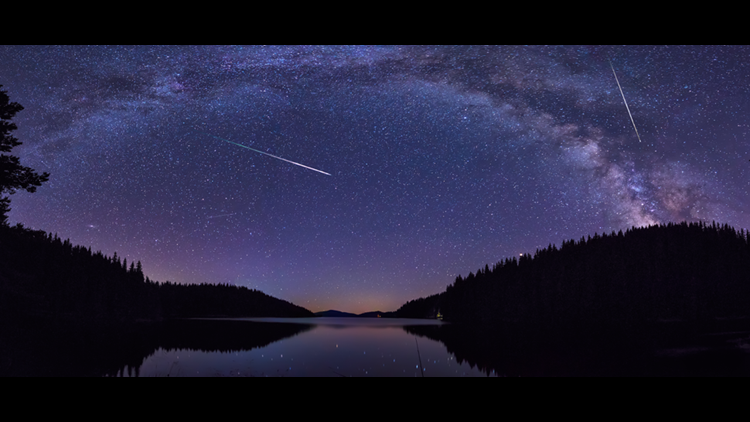INDIANAPOLIS (WTHR) - One of the best meteor showers of the year will peak tonight and will treat onlookers with nearly two dozen meteors per hour, as long as clouds do not interfere.
People planning to view the Orionid meteor shower should watch the skies tonight into the morning of Tuesday, Oct. 22 as the shower reaches its peak.
WTHR's Chuck Lofton says clouds will start to clear around midnight in central Indiana.
"I would rank the Orionids in the top five meteor showers of the year," AccuWeather Astronomy Blogger Dave Samuhel said. "It will be the strongest shower since the Perseids of August."
"Sparked by Halley's Comet, the Orionids provide 20 to 25 meteors per hour on the peak night," Samuhel said.
However, there have been several years in recent memory where the Orionids have exceeded expectations. "In exceptional years, such as 2006-2009, the peak rates were on par with the Perseids (50-75 per hour)," the American Meteor Society (AMS) said.
 A meteor glowing near the Milky Way. (Image/ScienceAtNASA)
A meteor glowing near the Milky Way. (Image/ScienceAtNASA)
Onlookers may spot shooting stars streaking across the sky beginning late Monday evening, but they will come in much greater numbers later in the night.
"This shower will be best viewed after midnight," Samuhel said. "If you can spot Orion, then get ready for some meteors."
This is because the shower's radiant point, or point of origin, is located near the constellation Orion which doesn't rise until after 11 p.m. local time. The higher the radiant point is in the sky, the higher the hourly rates of meteors per hour.
However, onlookers do not need to look at the radiant point to see meteors as they will appear in all areas of the sky.
Unfortunately, the moon will be a bit of an issue this year as it will rise just after midnight on the peak night, and will be around 50% illuminated, Samuhel said. This added light in the sky will make it more difficult to see some of the dimmer meteors, so late-night stargazers should look for meteors in parts of the sky away from the bright moon.
This year, the best viewing conditions are expected across the central and southwestern United States as cloud-free conditions are in the forecast during the peak of the Orionids.
Meanwhile, a large, far-reaching storm system will spread clouds across much of the eastern United States and into Ontario and Quebec, making it difficult to spot meteors on Monday night.
Disruptive clouds will also lead to poor viewing conditions across the Pacific Northwest and across the Canadian Rockies.
Clouds could also disrupt stargazers across Alaska with patchy clouds in the forecast over Hawaii.
Meteor showers occur when the Earth passes through a field of debris left behind by a comet or asteroid. Much of this debris is very small, ranging from the size of a grain of sand to a small pebble.
Despite their small size, they glow brightly as they burn up while entering Earth's atmosphere.
"The Orionid meteor shower is actually the second meteor shower of the year caused by Halley's Comet," Samuhel said.
"The Eta Aquariids in May are also triggered by tiny particles from the famous comet. But the Orionids are the more active of the two showers," he said.
Folks that miss the peak of the Orionids will have plenty of opportunities to look for shooting stars before 2019 comes to a close.
Four more meteor showers will reach their peak in the coming months, including the Geminids in mid-December. This shower regularly features over 100 meteors per hour.



